Trial Key to HELVELLACEAE and DISCINACEAE in the Pacific Northwest
Prepared for the Pacific Northwest Key Council
by Herold A. Treibs 1983, revised April, 2001
minor revision 2019, Ian Gibson
Copyright © 2001, 2019 Pacific Northwest Key Council
Photo copyright held by each photographer
Do not copy photos without permission
TABLE OF CONTENTS
Note on minor revision
Introduction
Key to Species
Glossary
References
Acknowledgements
Index
Helvella dryophila, H. albella, H. costifera, H. cupuliformis, H. lactea, Gyromitra leucoxantha, G. olympiana, and G. sphaerospora were added in the form of REMARKS with the initials - I.G. The first species was originally described in 2013. The others are from the work of Abbott and Currah, not used in the original key. H. vespertina replaced the misapplied name H. lacunosa. H. solitaria replaced the misapplied name H. queletii. H. latispora replaced its synonym H. stevensii. H. fibrosa replaced its synonym H. villosa.
The family Discinaceae had been split off from the family Helvellaceae, requiring a change in the name of the key. The disposition of names between Gyromitra and Discina has not been finalized. The approach taken by Beug et al.(2014) was to use only Gyromitra names and we have followed that here. The name Gyromitra ancilis replaced Discina perlata.
Comments on edibility are not endorsed by the reviser who would not eat any of these species.
The Helvellaceae are a family of ascomycetes with a fleshy fruiting body having a stem (stipe) on which is borne the spore-bearing head (pileus). The head is typically wrinkled or pitted, and the stem may be round in cross-section, ribbed, fluted, or pitted. (The term "head" is used instead of "cap" for the analogous structure in other genera to emphasize the different appearance.)
Characteristics which are most important in the field identification of Helvellaceae include the shape of the head; the shape of the stem; the shape and location of ribs and ridges on the stem and underside of the head; the presence or absence and shape of any openings or hollows in the stem; the texture of the surface; the color of the various parts of the fruiting body, including the upper surface of the head, the under surface, and the stem; the substrate on which it grows; and the time of the year in which it grows.
Colors tend to be various shades of brown or gray, occasionally white, sometimes nearly black. Although colors may be variable, both from one specimen to 'another and according to the age of the specimens, color is an important attribute in identification.
The hymenophore, the structure in which the spores are produced, is on the upper surface of the head. Spore color, in contrast to gilled and pore fungi, is not important in this field key, and is not listed. Spore size and shape are of some value, and in a few cases are the major difference in distinguishing otherwise similar fruiting bodies. To make it more useful to persons who will not be using a microscope, this key is intended to allow identification in most cases without the use of spore size and shape. If you do not have a microscope, just ignore the information on microscopic data in parenthesis. Be aware that in some cases, you will not be able to key to a specific species without microscopic examination of the specimen.
The genera included in this key are Discina, Gyromitra, and Helvella. There is no attempt to separate each of the included genera into their own section of this key, as to do so leads to complications in this key based on macroscopic characters.
Many of the included species have at times been placed in different genera by different authors, and species names may change as well. Thus, Gyromitra gigas has been listed as Helvella gigas by authors of some popular handbooks. And the mushrooms formerly known as G. gigas in the Pacific Northwest are now called Gyromitra montana, and the "real" G. gigas may not occur here at all! The names used herein have been used currently by many mycologists, but are subject to change by new interpretations. New interpretations based on DNA evidence are leading to assignment of species to different genera based on genetic relationships rather than on stature.
(Numbers in parenthesis at the beginning of a key lead refer to the previous lead.)
1a Head cup-shaped or flat, with or without wrinkles
................................................................................2
1b Head mitrate, convoluted, lobed, or saddle-shaped
................................................................................11
2a (1a) Stem lacking or typically less than half the height of the head
................................................................................3
2b Stem longer than half the height of the head
................................................................................7
3a (2a) With sharp ribs on stem, if present, and continuing at least 1/3 of the way up the outside of the cup
................................................................................Helvella acetabulum
| HEAD (cup) 1.5-5 cm broad, cup-shaped, inside gray-brown to dark brown, sometimes with a violet tint; outside with similar color near margin, becoming lighter to a pale cream color near the base, finely hairy to flaky near margin to smooth at base; ribbed, the ribs forking and not interconnected, round to sharp-edged, same color as outside surface or becoming cream color, especially if stem is well developed. STEM none to 9 cm long, 3 cm broad, broadening upward into the cup; same color as cup if very short; cream color if well developed. HABIT scattered to gregarious. HABITAT under hardwoods on well-drained soil, frequently along roads and paths; spring and early summer. EDIBILITY not known. MICROSTRUCTURES Spores 18-22 x 11-14 micrometers, broadly ellipsoid, smooth, with central oil droplet. REMARKS Helvella costifera will also key here. It was examined from Washington and Idaho by Abbott and Currah. H. costifera is in the same group as H. acetabulum. Michael Kuo discussed the species and wrote, “North American mycologists have used four characters to separate Helvella costifera from Helvella acetabulum: It has a gray, rather than yellow-brown, cap; the ribs on its stem are generally rounded and blunt-edged, rather than sharp-edged; its spores are sometimes slightly smaller; and the pigment in the cells of its excipular surface resides only in the cell walls, rather than inside the cells.” - I.G. | Helvella acetabulum
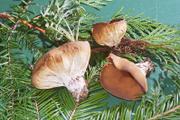
Michael Beug |
3b Without sharp ribs on outside of head (cup)(but may have ridges on stem)
................................................................................4
4a (3b) With broad ridges on stem, if present, continuing to base of cup which appears folded or gathered
................................................................................Helvella leucomelaena
| HEAD (cup) 1-6 cm broad, 1-4 cm high, cup-shaped, margin straight to flaring, edge entire to scalloped in age; gray to dark brownish gray or blackish, outside nearly the same color as the inside of the cup or lighter, becoming cream color or off-white to white at the base; outside finely granulose-roughened; base appears folded or gathered, ribs broad and not distinct from other parts in shape, color, or texture, not reaching the margin. STEM poorly developed or absent, stem area expanding smoothly into cup with broad ribs which taper out. HABIT scattered to gregarious. HABITAT on compacted well-drained soil along roads and paths, frequently under pine; spring and early summer. EDIBILITY not known. MICROSTRUCTURES Spores 20-24 x 10-14 micrometers, round oblong, with a single oil droplet, smooth. REMARKS A related species is H. crassitunicata, which resembles H. leucomelaena. It differs principally by larger spore size (23-26(-28) x 13.5-15 micrometers), and by fruiting in the late summer and fall. | Helvella leucomelaena
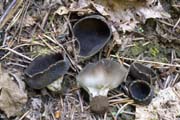
Steve Trudell |
4b Stem, if present, is smooth, pitted, or with ridges, but base of head is not folded or gathered
................................................................................5
5a (4b) Head cup-shaped or flattened
................................................................................6
5b Head not cup-shaped or flattened
................................................................................8
6a (5a) Head appears waxy
................................................................................Gyromitra melaleucoides
| HEAD flat to cup-shaped, sometimes slightly convoluted, large, up to 10 cm diameter, light to dark brown on top, lighter brown underneath; underside of head appears waxy when fresh, without prominent ridges; (underside frequently turns white as the specimen ages, so the waxy appearance is no longer evident). STEM short, up to 3 cm long, up to 1 cm diameter, with blunt ridges, same color as underside of head. HABITAT grows on ground or duff and rotting wood in coniferous woods, spring. EDIBILITY not known. MICROSTRUCTURES Spores ellipsoid, 10-13 x 7-10 micrometers, with low warts and short ridges on surface, one or usually two oil drops. REMARKS G. melaleucoides is often confused with Gyromitra ancilis. Identification should be confirmed by checking mature spores in a spore deposit, which are smaller (11.5-14.5 x 8-9.5 um as opposed to 25-45 x (8)11-16 um for G. ancilis according to Beug et al.). The spores of Gyromitra leucoxantha and Gyromitra olympiana are similar in size to those of G. ancilis. – I.G.
| Gyromitra melaleucoides
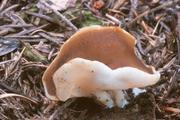
Michael Beug |
6b Head not waxy
................................................................................Gyromitra ancilis
| HEAD cup-shaped, expanding to saucer-shaped with wrinkled upper surface and with edges curved downward, 4 to 10 cm wide, top tan to dark brown, underside pallid, not waxy, no prominent ribs. STEM lacking or up to 1 cm long and up to 1 or 2 cm diameter, smooth or pitted (lacunose). HABIT scattered or gregarious. HABITAT on humus or rotten wood under conifers in the spring. EDIBILITY edible. MICROSTRUCTURES Spores fusoid, 30-35 x 12-14 micrometers with apiculus 1 to 3.5 micrometers long at each end. REMARKS 1) Gyromitra olympiana would usually key out here. It has a shape similar to Gyromitra ancilis, but the color is more like Gyromitra montana, i.e. typically yellow brown to brown (becoming red-brown in age). The identification can be confirmed by examining mature spores in a spore print (not in the asci). There should be some spores that have developed a broad, blunt thickening at both ends of some mature spores, whereas G. ancilis shows some spores that have developed a thick pointed apiculus at both ends. 2) An unnamed Gyromitra has similar spores to G. olympiana but is consistently small (1.5-4.5 cm wide, stem if present up to 1 cm x 1 cm), with the upper surface is pinkish buff, and the lower surface off-white, drying tan, and minutely pubescent. 3) Gyromitra leucoxantha is typically yellow to orange or orange-brown, drying bright red-brown or brown. Identification should be confirmed by examining mature spores in a spore print (not in the asci). There should be some spores that have developed a depressed (i.e. concave) thickening in both ends. – I.G. Other cup- or saucer-shaped fruiting bodies which are not included in Helvellaceae may be encountered, and these also are not included in this key. The distinction is based largely on microscopic characters.
| Gyromitra ancilis
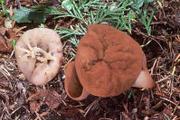
Michael Beug |
7a (2b) Interior of cup black, exterior and stem brown to black
................................................................................Helvella corium
| HEAD (cup) 1-6 cm wide, cup-shaped, the margin somewhat wavy, the exterior hairy, interior (top) black, exterior dark brown to black, margin often with whitish tufts or warts. STEM 1-3 cm long, 2-5 mm thick, round or slightly compressed, ridges, if any, very faint and not continuing into head, black at upper part, often dingy gray at base. HABIT solitary to small clusters. HABITAT on ground, early summer. EDIBILITY not known. MICROSTRUCTURES Spores 17-20 x 10-13 micrometers, oblong to ellipsoid, one large oil droplet, smooth. REMARKS Plectania nannfeldtii is similar in appearance, but grows on wood, often buried sticks, with a stem several cm long through the duff. It is of the family Sarcosomataceae. | Helvella corium
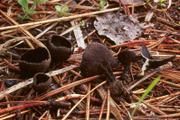
Andrew Parker |
7b Interior of cup shades of gray or brown, but not black
................................................................................8
8a (5b, 7b) Stem with 4 to 7 regular blunt ribs
................................................................................Helvella solitaria
| HEAD (cup) 2-8 cm broad, saucer-shaped, in age sometimes recurved toward the stem, the margin split at times, top pale brownish to dark grayish brown, with or without violet tinge, exterior of cup even, yellowish gray, with short downy hairs (pubescent). STEM 2-6 cm long, 8-10 mm thick, ribbed with 4 to 7 regular blunt ribs, pale grayish tan to nearly white, pubescent. HABITAT grows on sticks and debris in wet places in the summer; rare. EDIBILITY not known. MICROSTRUCTURES Spores 17-21 x 11-13.5 micrometers. | Helvella solitaria
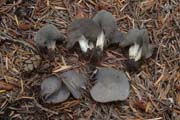
Andrew Parker |
8b Stem smooth or hairy, but not ribbed
................................................................................9
9a (8b) Interior of cup whitish to cinnamon brown
................................................................................Helvella latispora
| HEAD up to 2 cm broad, upper surface whitish to cinnamon brown when fresh, pubescent (slightly hairy), under surface whitish, slightly pubescent; head may be cup- or saucer-shaped, sometimes saddle-shaped; margin of head remaining inrolled over the upper surface for some time. STEM 1.5-3(5) cm long, 2-4 mm thick, terete (round) or slightly flattened, solid, same color as underside of head, pubescent. HABIT scattered to gregarious. HABITAT on humus in mixed conifer and hardwoods or in hardwood forests, along roads or edges of clearings in woods; early summer. EDIBILITY not known. MICROSTRUCTURES Spores 18-19.5 x 11.5-13 micrometers, paraphyses slightly enlarged above to 5-7 micrometers wide. REMARKS Helvella albella is likely to key out here via lead 25a. Features include 1) relatively small size like H. latispora, 2) a medium to dark brown or gray-brown cap that is irregularly lobed or with two lobes and saddle-shaped, the cap underside whitish and downy or mealy, 3) a stem that is white and round or shallowly fluted, the cap margin not attached to stem, 4) fall fruiting, and 5) microscopic characters. | Helvella latispora
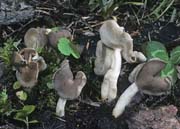
Kit Scates Barnhart |
9b Interior of cup gray, grayish brown, or yellowish brown
................................................................................10
10a (9b) Cup gray, grayish brown, or steel gray
................................................................................Helvella fibrosa
| HEAD (cup) 1-2.5 cm wide, cup-shaped, compressed when young, becoming saucer-shaped at maturity, splitting into several irregular lobes, exterior pubescent (slightly hairy) to villose (hairy); gray, grayish brown, to steel gray, under side grayish to dark brown to steel gray. STEM 1-3 cm long, terete (round), solid, same color as underside of head, becoming paler and yellowish at base. HABIT scattered. HABITAT on sandy soil in damp woods and along streams under hardwoods, early summer to fall. EDIBILITY not known. MICROSTRUCTURES Spores 17-21 x 9-13 micrometers, oblong to ellipsoid, one large and 0 to 5 small oil droplets, usually smooth. REMARKS See comments under 10b H. macropus. | Helvella fibrosa
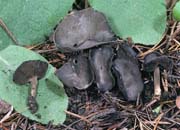
Kit Scates Barnhart |
10b Cup yellowish brown to pale grayish brown
................................................................................Helvella macropus
| HEAD (cup) 2-3 cm broad, cup-shaped, margin at first curving over upper surface, then plane to incurved, yellowish brown to pale grayish brown; underside similar to top, but usually lighter, hairy, especially near the margin. STEM 2-4 cm long, 1.5-5 mm thick, when young round and even, in age compressed, larger at base; similar in color to outside (bottom) of cup, off-white at base. HABIT solitary to scattered, occasionally gregarious. HABITAT on soil or rotting wood, summer through fall. EDIBILITY not known. MICROSTRUCTURES Spores 21-24 x 10-13 micrometers, one large and 2 small oil droplets, warts on surface. REMARKS Helvella cupuliformis will also key out here. It has been found in Oregon but it rare. Spores are 18.4-21.0 x 11.4-12.2 um (versus 18-25.1 x 10.3-12.2 um for H. macropus according to Abbott & Currah) and the coloring is subtly different. – I.G. H. macropus has been confused with H. fibrosa. H. macropus tends to be lighter in color and more villose (hairy) than H. fibrosa. H. fibrosa has a greater tendency for the cup to split into irregular lobes at maturity. | Helvella macropus
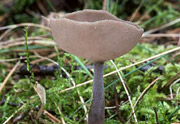
Boleslaw Kuznik |
11a (1b) Head convoluted or brain-like
................................................................................12
11b Head saddle-shaped, folded, wrinkled, mitrate, or with 2 or 3 lobes
................................................................................16
12a (11a) Stem deeply and irregularly fluted, like thin ribs running down stem
................................................................................Gyromitra californica
| HEAD up to 10 cm or more broad, strongly spreading and inflated, upper surface uneven to convoluted, brown, olive brown, or light to dark grayish brown. STEM up to 10 cm long and up to 6 cm wide, deeply and irregularly fluted, ribs thin and deep, white to pallid, near base tinted pink, reddish, or dingy vinaceous yellowing in age, brittle. HABIT solitary to scattered. HABITAT on soil along streams, skid trails through woods, and recently disturbed soil, spring and early summer. EDIBILITY poisonous due to monomethylhydrazine; see discussion under G. infula. MICROSTRUCTURES Spores ellipsoid,14-17 x 8-9 micrometers, with two small oil droplets. REMARKS Gyromitra sphaerospora can key out here. Suspect this rare species when growing on hardwood, and confirm by finding round spores 9-12 x 9-12 um. – I.G.
| Gyromitra californica
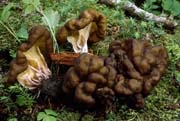
Steve Trudell |
12b Stem round, slightly flattened, or with blunt ridges
................................................................................13
13a (12b) Stem very thick, usually over half the diameter of the head, often mostly covered by head
................................................................................Gyromitra montana
| HEAD 4-10 cm wide, 4-6 cm high, folded or wrinkled, attached to the stem in various places, yellowish brown to smoky brown or dingy bay, sometimes cracked and showing white in the cracks. STEM white, width only slightly less than head, length about the same as width, sometimes enlarged at base, with several interfolded hollows. HABIT grows singly or gregarious. HABITAT in the spring or early summer, often near melting snowbanks, on soil under or near conifers. EDIBILITY Many people consider these edible and choice in the Pacific Northwest. There seems to be no evidence of poisoning from these mushrooms in the Pacific Northwest, where many people eat them. However, these or related species have caused poisonings, in some cases fatal, in eastern North America and Europe. The poisoning has been attributed to monomethylhydrazine, discussed under G. infula. MICROSTRUCTURES Spores: G. montana, elliptic, flattened on one side, 1 large and two small oil drops, smooth or faintly roughened, (21.4) 24.3-35.8 (37.5) x (9) 10.7-15.8 micrometers, apiculus blunt, lacking, or not over 1 micrometer long; G. korfii, fusiform to narrowly elliptic, flattened on one side, one large and 2 small oil drops, smooth to faint ridges, 25-30 x 10.8-12.6(14) micrometers, including 1.5 to 2 micrometer round or blunt knob-like apiculus at each end. REMARKS The name G. gigas has been in common use in naming mushrooms with the above description in the Pacific Northwest. There are at least two similar mushrooms in the Pacific Northwest, G. montana Harmaja and G. korfii (Raitviir) Harmaja, but these are distinguishable only by microscopic examination of the spores. The description given above is for G. montana Harmaja. G. montana and G. korfii are similar, both in appearance and edibility. G. korfii has been called G. fastigiata by some authors, but G. fastigiata is now generally applied to a different mushroom with a more lobed head that is not known to occur in the Pacific Northwest. There has been considerable confusion in the proper name for these and related species. | Gyromitra montana
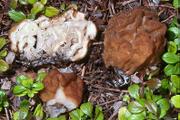
Michael Beug |
13b Stem usually much less than half the width of the head
................................................................................14
14a (13b) Head slightly convoluted and flattened, stem short or very short
................................................................................6a G. melaleucoides
14b Head convoluted or brain-like, not flattened, with obvious stem
................................................................................15
15a (14b) Head markedly convoluted or brain-like when mature, (may be smooth when young), typically in spring or early summer
................................................................................Gyromitra esculenta
| HEAD 3 to 10 cm broad, smooth at first but soon becoming wrinkled or folded all over; yellowish, yellowish brown, reddish brown, bay brown or darker. STEM 2 to 5 cm long, 1 to 2 cm thick, colored similar to the head but often lighter, round with a single round hollow, or sometimes compressed to have a flattened or double hollow. HABIT grows scattered to gregarious. HABITAT early in the spring or in the mountains in early summer, on humus under conifers. EDIBILITY Although eaten by some people in the Pacific Northwest, there is risk in eating this mushroom, and they are not recommended for food. See the discussion of monomethylhydrazine under G. infula. Parboiling in an open vessel and discarding the water reduces but does not eliminate the risk. MICROSTRUCTURES Spores 17-22 x 7-9 micrometers, smooth. | Gyromitra esculenta
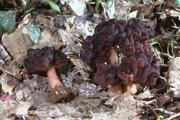
Michael Beug |
15b Head somewhat convoluted, usually with two pointed lobes, typically in late summer or fall
................................................................................Gyromitra infula
| HEAD in the shape of a saddle with two or sometimes three pointed lobes whose tips rise above the saddle, 3 to 10 cm broad, margin usually curved upward toward the upper surface, even to wrinkled or somewhat convoluted, yellow brown, reddish brown to dark brown. STEM 1 to 6 cm long, up to 2 cm thick, round in section to somewhat irregular, with a single hollow, or if somewhat flattened, sometimes with two hollows, smooth or irregular surface, dull reddish brown. HABIT grows solitary to scattered. HABITAT on rotting wood or ground containing rotting wood, sometimes spring, usually summer and fall. EDIBILITY Although eaten by some people in the Pacific Northwest, there is a considerable risk in eating this mushroom. Some specimens, particularly in other parts of the country, contain monomethylhydrazine or other compounds that liberate monomethylhydrazine upon ingestion. The difference between an amount causing no noticeable effect and fatal poisoning can be very slight. Furthermore, there are indications that monomethylhydrazine is carcinogenic, even when ingested in amounts that do not produce immediate symptoms of poisoning. Parboiling in an open vessel and discarding the water reduces the risk somewhat, as the poison is volatile and water soluble. MICROSTRUCTURES Spores 15-18 x 6-8 micrometers, smooth, narrowly ellipsoid, with 2 oil droplets, no perispore. REMARKS G. ambigua is a related species which has been found in Alaska and Scandinavia and may occur in the Pacific Northwest. G. ambigua has larger spores, 22-30(37) x 7.5-12.0 micrometers (20-25 micrometers long without the perispore), each containing 2 oil droplets and with a hyaline membrane (perispore) covering the entire spore and conspicuous at each end. Some populations of G. ambigua in Europe have a violet tinge which helps distinguish them from G. infula, but this has not been demonstrated in North American specimens. Otherwise, the two species are virtually identical except for the spores. | Gyromitra infula
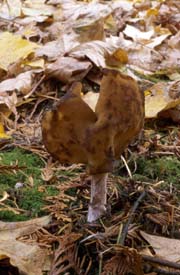
Steve Trudell |
16a (11b) Head mitrate
................................................................................Helvella vespertina
| HEAD 1.5-5 cm broad, mitrate to saddle-shaped with 2-3 lobes, margin attached to stem in places, surface even or wrinkled toward center, upper surface pale gray to blackish, under surface pale gray, grayish brown, or nearly black, smooth but sometimes with ribs extending from point of attachment with stem, sometimes to the margin, ribs sometimes branching; some specimens are a pale creamy white, due to lack of pigment; some may be white due to being overgrown by a parasitic mycelium, and the surface is then somewhat roughened. STEM 6-13 cm long, 1-3 cm thick, deeply furrowed, the ribs sharp, sometimes double-sided, interconnecting, the interior of the stem having longitudinal chambers, dingy white to gray or black. HABIT scattered to gregarious. HABITAT on the ground or sometimes on decaying wood in deciduous and conifer forests, late summer and fall, scattered to gregarious, common in many localities. EDIBILITY edible. MICROSTRUCTURES Spores 17-21 x 10-14 micrometers, ellipsoid, usually smooth, with one oil droplet. REMARKS Helvella dryophila, described in 2013, will also key out here. H. dryophila is similar to H. vespertina but according to the original description, 1) the host is different (oak instead of conifer), 2) the contrast in colour between the cap and stem is striking, 3) the cap "is very dark and squat and rounded with distinct well defined grooves when young", and 4) the fruitbodies are only up to 8.5 cm tall. Michael Beug (pers. comm.) points out however that with Helvella dryophila there is often little contrast between cap and stalk color and sometimes the cap is brownish or gray, not always black. The distinctive features are squat appearance and late winter-spring fruiting. Helvella vespertina tends to fruit in fall, and Helvella dryophila in spring. – I.G. In addition, Michael Beug (pers. comm.) has found an undescribed Helvella, also fruiting in spring and squat in stature, but associated with conifers, with a fatter stem composed on 1 mm thick tissue folded and pleated and lacking the strength to hold up the cap very well. – I.G. White forms of H. vespertina can occur in pale forms but is still gray in fresh and dry specimens. Helvella lactea has been examined from Washington by Abbott and Currah – it is entirely white when fresh, and yellow especially on the stem when dried. At least one author has considered H. lactea to be a white form of H. lacunosa (in the Pacific Northwest then falling under H. vespertina). – I.G. | Helvella vespertina
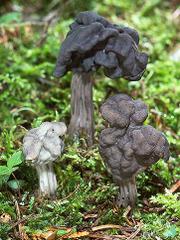
Michael Beug |
16b Head saddle-shaped, folded, wrinkled, or with 2 or 3 lobes
................................................................................17
17a (16b) Head saddle-shaped
................................................................................18
17b Head other shapes
................................................................................28
18a (17a) Head whitish to cream color
................................................................................19
18b Head darker, shades of gray or brown to black
................................................................................20
19a (18a) Stem ribbed and furrowed
................................................................................Helvella crispa
| HEAD 1.5-6 cm broad, saddle-shaped or irregular with 2-3 lobes, margin inrolled to obscure the entire upper surface when young, then becoming expanded, touching the stem in places, upper surface whitish to light buff, wrinkled and often irregular; under surface same color as upper surface or slightly darker, slightly roughened to hairy. STEM 3-8 cm long, 0.5-2.5 cm thick, tapering upward, minutely hairy, white to whitish, having interconnecting ribs and furrows, interior chambered; ribs at first rounded, becoming sharper in age. HABIT solitary to gregarious. HABITAT on ground or rotting wood debris, in coniferous and deciduous forests, from August to frost. EDIBILITY not recommended. MICROSTRUCTURES Spores 17-21 x 10-13 micrometers, ellipsoid, with one central oil drop and 0-4 small droplets at each end, usually smooth. REMARKS See also 16a, for H. lactea and white forms of H. vespertina. | Helvella crispa
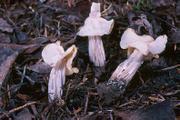
Michael Beug |
19b Stem round, without ridges or furrows
................................................................................9a H. latispora
20a (18b) Head very dark gray or black
................................................................................21
20b Head shades of gray or brown
................................................................................23
21a (20a) Head black, small (1-2 cm broad), dark round stem
................................................................................Helvella atra
| HEAD 1-2 cm broad, usually saddle-shaped or irregularly lobed, upper surface black, under surface smoky brown to blackish, glabrous (smooth), usually saddle-shaped or irregularly lobed. STEM 4-5 cm long, 2-3 mm thick, solid, round or slightly flattened, with 1 or 2 grooves near the base, which is slightly enlarged, pubescent to villose (slightly hairy to hairy), gray to grayish brown, upper part darker, sometimes nearly black, base yellowish gray to whitish. HABIT scattered to gregarious. HABITAT on soil under ponderosa pine in the fall, rare. EDIBILITY not known. MICROSTRUCTURES Spores 17-20 x 9-12 micrometers, oblong to ellipsoid, one central oil droplet, smooth. | Helvella atra
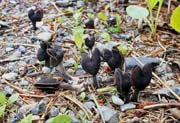
Andrew Parker |
21b Head dark gray to black, small to medium size (0.5 to 5 cm broad), stem with pronounced ribs
................................................................................22
22a (21b) Stem with ridges with prominent interconnections appearing like rectangular pits and having ribs on under surface of head
................................................................................16a H. vespertina
22b Stem with prominent ridges, interconnections rare, underside of head smooth
................................................................................Helvella sulcata
HEAD 0.5-5 (occasionally up to 14) cm broad, saddle-shaped with shallow to acute curve, or with three lobes, even or slightly wrinkled, brown or pale drab gray to black; under surface pale drab gray to dark gray, paler than the upper surface, smooth and even, when young free but in age often ingrown with itself or stem. STEM 1.5-6(15) cm long, 0.5-2(3) cm thick, nearly equal over entire length, ribbed, the ribs pleat-like and single edged to low cord-like and double edged, branching, occasionally with pits near the base; pale to dark gray. HABIT solitary to gregarious. HABITAT on the ground or on rotting hardwood debris, sometimes in mixed woods or conifer debris, late spring to late fall. MICROSTRUCTURES Spores 15.5-18 x 10.5-12.5 micrometers, ellipsoid, with one oil droplet, smooth. REMARKS Some authors consider H. sulcata merely a form of H. lacunosa. [Presumably the same remark applies to H. vespertina in the place of H. lacunosa. – I.G.]
23a (20b) Stem white or nearly white
................................................................................24
23b Stem not white or whitish
................................................................................28
24a (23a) Stem round or somewhat flattened, not ridged
................................................................................25
24b Stem with prominent ridges or ribs
................................................................................27
25a (24a) Underside of head smooth (not hairy), margin of head turning toward stem especially when young
................................................................................Helvella elastica
| HEAD 1-4 cm broad, saddle-shaped to bell-shaped, lower lobes frequently touching stem, upper surface pale brown to buff, at times with a violet tinge, under surface whitish to creamy buff, glabrous (smooth), margin curving toward stipe and occasionally intergrown with it. STEM 1.5-10 cm long, 3-10 mm thick, tapering upward, terete (round), hollow, cream color to pale buff, smooth or appearing lightly frosted near the top. HABITAT on ground, in deciduous and coniferous woods, summer and fall. EDIBILITY not known. MICROSTRUCTURES Spores 18-22 x 11-14 micrometers, ellipsoid to oblong, large oil droplet and 0-5 small oil droplets at each end, usually smooth. REMARKS Helvella albella could key here because the margin of the head turns toward the stem when young (but the underside of the head is then hairy) and the underside of the head can be smooth when old. See Remarks under H. compressa for features. – I.G. | Helvella elastica
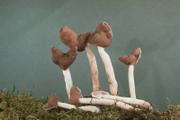
Ben Woo |
25b Underside of head slightly hairy to hairy, margin of head turning over upper surface when young
................................................................................26
26a (25b) Upper surface of head whitish to cinnamon brown
................................................................................9a H. latispora
26b Upper surface of head medium to dark brown or grayish brown
................................................................................Helvella compressa
| HEAD 1.5-5 cm high, 1.5-3.5 cm broad, saddle-shaped or 3-lobed; upper surface even, medium to dark brown or grayish brown; margin at first curved over the upper surface, gradually unrolling in age, with or without splitting in age; underside pubescent to villose (slightly hairy to hairy), white to pale cream color. STEM white to pale cream, equal or tapering toward top, 3-8 cm long, 3-17 mm thick, round to flattened or pitted near base, finely hairy. HABIT scattered to gregarious. HABITAT in duff, oaks and pines along Pacific coast, spring. EDIBILITY not known. MICROSTRUCTURES Spores 19.5-21 x 12-14 micrometers, rounded oblong to broadly ellipsoid, with large central oil drop. REMARKS Helvella albella is likely to key out here. Features include 1) relatively small size like H. compressa, 2) a medium to dark brown or gray-brown cap that is irregularly lobed or with two lobes and saddle-shaped, the cap underside whitish and downy or mealy, the cap inrolled to incurved at first, becoming flared to bent upward when mature, 3) a stem that is white and round or shallowly fluted, the cap margin not attached to stem, 4) fall fruiting, and 5) microscopic characters. – I.G. | Helvella compressa
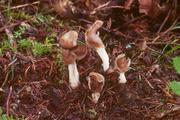
Michael Beug |
27a (24b) Underside of head with prominent ribs or ridges which often branch, often intergrown with stem
................................................................................16a H. vespertina
27b Underside of head without ribs or with ridges scarcely extending down from stem; rarely intergrown with stem
................................................................................Helvella maculata
| HEAD 0.8-6 cm broad, saddle-shaped to three-lobed; when young, the margin rolling upward and completely covering the upper surface, gradually expanding and unrolling until at maturity it is flaring and often splitting; upper surface mottled, shades of brown or grayish brown; the under surface cream color when young, becoming lemon yellow with grayish areas in age, with dense fine hairs, even except for a few short ribs near but usually not touching the stem. STEM 1.5-10 cm long, 0.4-3 cm thick, ribbed, the ribs rounded and often forked and interconnecting, pure white to pinkish buff when young, becoming dark grayish brown, especially on the ribs, with shallow pits, nearly hairless. HABIT scattered to gregarious. HABITAT under conifers and mixed woods; spring, late summer and fall. EDIBILITY not known. MICROSTRUCTURES Spores 20-23 x 12-13.5 micrometers, rounded oblong to bluntly ellipsoid, with one large central oil drop and often several small droplets near each end, smooth. | Helvella maculata
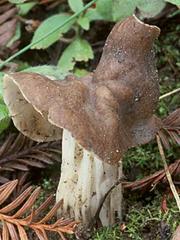
Boleslaw Kuznik |
28a (17b) Stem ribbed or furrowed, the ribs often with sharp edges or double-edged
................................................................................29
28b Stem round or flattened, but without ribs or furrows
................................................................................30
29a (28a) Underside of head without ribs
................................................................................22b H. sulcata
29b Underside of head with ribs extending from the stem toward margin, the ribs often branching and/or appearing interconnected
................................................................................16a H. vespertina
30a (28b) Head yellowish brown, reddish brown, to dark brown
................................................................................15b G. infula
30b Head gray, grayish brown, or brownish gray
................................................................................31
31a (30b) Head cup-shaped or saucer shaped, sometimes splitting (may appear folded upward and pressed together when young)
................................................................................10a H. fibrosa
31b Head saddle-shaped with corners touching or nearly touching
................................................................................Helvella pezizoides
HEAD 1.5-4 cm broad, saddle-shaped with the upper corners nearly or completely touching, margin curving upward when young, expanding in age, the lobes of head then pressed against stem; edges entire or occasionally appearing torn; upper surface drab gray to dark brownish gray; lower surface slightly paler than top, slightly hairy to hairy, in age ingrown with other parts. STEM 3-4 cm long, 3-10 mm thick, terete (round) to compressed (flattened), even or with shallow pits near the base, tapering upward, color similar to lower side of head to lighter at base, slightly hairy to hairy (villose). HABIT scattered to gregarious. HABITAT on hardwood debris or on ground, middle to late summer, rare. EDIBILITY not known. MICROSTRUCTURES Spores 17-20 x 10-12 micrometers, oblong to ellipsoid with single large oil drop, usually smooth. REMARKS H. pezizoides is difficult to distinguish from H. ephippium, and the foregoing description applies to both species. H. ephippium tends to be larger and grayer and lighter than H. pezizoides, which is darker brown to blackish. (Microscopically, hyphae of apothecium seldom with brown walls in H. ephippium; frequently with brown walls in H. pezizoides, especially at junction of medullary and ectal excipula.)
mitrate - Like a mitre, a two-peaked hat with a notch in the middle.
saddle-shaped - Folded and bent to make a notch, like a Chinese fortune cookie.
- Abbott, Sean P. and R.S. Currah. 1997. “The Helvellaceae: systematic revision and occurrence in northern and northwestern North America.” Mycotaxon 62: 1-125.
- Beug, Michael, Alan E. Bessette, Arleen Bessette. 2014. Ascomycete Fungi of North America: A Mushroom Reference Guide. University of Texas Press. 488 pp.
- Dissing, H. 1966. "The Genus Helvella in Europe", Dansk Botanisk Arkiv, Bind 25, Nr. 1.
- Harmaja, H. 1969. "A neglected species, Gyromitra ambigua (Karst.) Harmaja, n. comb., and G. Infula s. str. in Fennoscandia." Karstenia 9: 13-19.
- Kempton, P.E., VL Wells. 1973. "Studies on the Fleshy Fungi of Alaska. VI. Notes on Gyromitra." Mycologia 65(2): 396-400.
- Kuo, Michael. Accessed Sep. 12, 2019. Helvella costifera. Retrieved from the www.MushroomExpert.com Web site https://mushroomexpert.com/helvella_costifera.html.
- McKnight, K.M. 1969. "A Note on Discina." Mycologia, 61(3): 614-630.
- McKnight, K.M. 1971. "On Two Species of False Morels (Gyromitra) in Utah." Great Basin Naturalist, 31(2): 35-47.
- McKnight, K.M. 1973. "Two Misunderstood Species of Gyromitra (False Morels) in North America." The Michigan Botanist 12: 147-162.
- Miller, Jr., O.H. 1978. Mushrooms of North America. E.P. Dutton, New York.
- Pfister, D.H. 1980. "On 'Peziza' melaleucoides — A Species of Gyromitra from Western United States." Mycologia, 72(3): 614-619.
- Seaver, F.J. 1928. The North American Cup-fungi (Operculates) Lubrecht & Cramer reprint 1978.
- Smith, A.H., Helen V. Smith and Nancy Smith Weber. 1981 How to Know the Non-Gilled Mushrooms, Second Edition, Wm. C. Brown Co., Dubuque. 280p.
- Weber, Nancy Smith. 1972. "The Genus Helvella in Michigan." The Michigan Botanist, 11: 147-201.
- Weber, Nancy Smith. 1975. "Notes on Western Species of Helvella. I.," in "Studies on Higher Fungi. A Collection of Papers Dedicated to Dr. Alexander H. Smith on the Occasion of his Seventieth Birthday," Bigelow and Thiers, ed., Beiheft zur Nova Hedwigia, Bind 51: 25-38. J. Cramer.
- Weber, Nancy Smith. 1988. A Morel Hunter’s Companion. Two Peninsula Press, Lansing, Michigan.
- Wells, V.L., P.E. Kempton, "Studies on the Fleshy Fungi of Alaska II." Mycologia 60(4): 888-901.
The references by NS Weber, and by AH Smith, HV Smith, and NS Weber form the nucleus of the present key, and their contributions are gratefully acknowledged. They were most helpful in supplying reprints and an advance copy of the first edition of How to Know the Non-Gilled Mushrooms. I also greatly appreciate reprints supplied by KM McKnight, PE Kempton, and J. Ammirati. The late DE Stuntz provided helpful suggestions and access to the publication by Dissing. Kit Scates-Barnhart provided encouragement and slides and specimens which would otherwise not have been available to me. I especially appreciate the assistance by M Beug and mycology students at The Evergreen State College, Olympia, WA, for extensive field trials of the key which helped remove some rough spots.
| GENUS AND SPECIES |
KEY ENTRIES |
| |
|
| GYROMITRA Fr. |
|
| G. ambigua |
see 15b |
| G. ancilis |
6b |
| G. californica |
12a |
| G. esculenta |
15a |
| G. fastigiata |
see 13a |
| G. gigas |
see 13a |
| G. infula |
15b |
| G. korfii |
see 13a |
| G. leucoxantha |
see 6a, 6b |
| G. melaleucoides |
6a, 14a |
| G. montana |
13a |
| G. olympiana |
see 6b |
| G. sphaerospora |
see 12a |
| |
|
| HELVELLA L. |
|
| H. acetabulum |
3a |
| H. albella |
see 9a, 25a |
| H. atra |
21a |
| H. compressa |
26b |
| H. costifera |
see 3a |
| H. crassitunicata |
see 4a |
| H. corium |
7a |
| H. crispa |
19a |
| H. cupuliformis |
see 10b |
| H. dryophila |
see 16a |
| H. elastica |
25a |
| H. ephippium |
see 31b |
| H. fibrosa |
10a, 31a |
| H. lactea |
see 16a, 19a |
| H. latispora |
9a, 19b |
| H. leucomelaena |
4a |
| H. macropus |
10b |
| H. maculata |
27b |
| H. pezizoides |
31b |
| H. solitaria |
8a |
| H. sulcata |
22b, 29a |
| H. vespertina |
16a, 19a, 22a, 27a, 29b |
- END -





